
As kitchens get a robust workout due to more people cooking and working at home, design professions have responded with chic, functional updates.
Kitchen trends are like fashion—wait a season and this color will be in and that one out. But the changes since the start of the pandemic a year ago have emerged to keep the room true to its moniker as the heart of the house.
With more people working remotely—and cooking all their meals at home—the kitchen has become more than a place to prepare food. It’s transitioned to an all-in-one work, gathering, eating, and storage hub, says designer Prosha Korangy of Prosha Design.
Or as interior designer Ximena Rodriguez, a principal and director of interior design at CetraRuddy Architecture, puts it, “It has become a space to enjoy living.”
From cabinetry and appliances to lighting and smart technology, 2021 kitchen trends have arisen as highly functional and beautiful, says Liz Brooks, executive vice president of sales and marketing at developer Belgravia Group.
While some changes started before COVID-19 hit, others kicked in after stay-at-home orders spread. Many homeowners realized “the importance of their home as their refuge,” says Mick De Giulio, owner of deGiulio Kitchen Design. That spurred homeowners with funds and access to contractors to proceed with remodeling projects, he says.
Here are 10 kitchen changes most sought after by homeowners in 2021:
1. Flexible instead of open layouts.
The number of homeowners renovating interiors to gain an open-concept plan has dropped since 2019, according to the 2021 U.S. Houzz Kitchen Trends Study. Instead, it’s evolved into a desire for flex space—a reimagined open concept. Since the pandemic started, designer Jodi Swartz found many homeowners hiring her KitchenVisions firm to take down walls “to keep an eye on their children while cooking,” she says. Other homeowners sought an adjacent space to keep work, hobbies, or play out of the main living space.
Within the kitchen layout, De Giulio says the work triangle of the sink, refrigerator, and cooktop being close proximity is still paramount. But with more people congregating in the kitchen, design is shifting to add ancillary zones. Peter Albanese, vice president of kitchen and bath at Bellari Home Remodeling, often puts a charging station near a kitchen entry. De Giulio likes to include a “LaMattina” or morning breakfast center. A baking center has gained interest, according to Houzz, as more homeowners prepare breads and cakes, and post in cooking groups like KitchenQuarantine. Many homeowners also want a comfortable seating area for eating, working, schmoozing, which Interior Makeovers designer Lori Gilder likes to put in a windowed corner, preferably with a banquette.
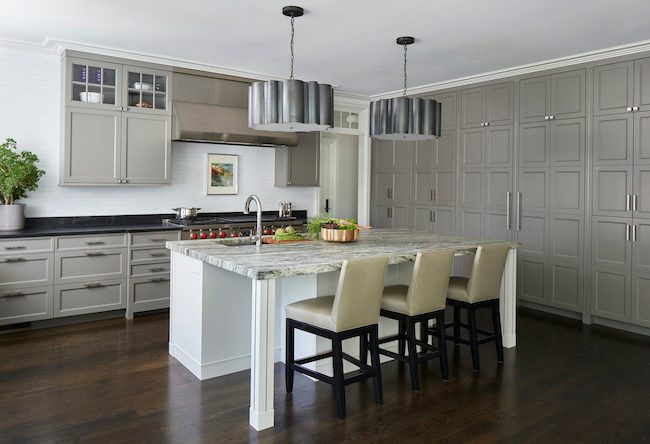
2. Bigger islands.
“The bigger the better” seems to be the rule, and larger kitchen island designs could replace a table, says Linda Fennessy of Kitchen Magic. Just how big is big? “Enormous,” says architect Bob Zuber with Morgante Wilson Architects, who cites 7×14½ feet as common, so that it can fit several people sitting or working together, plus room for a sink, dishwasher, and microwave. Architects Stuart Cohen and Julie Hacker like to make gathering around these islands more comfortable by rounding corner edges, while designer Susan Brunstrum of Studio Brunstrum recommends chairs or swivel stools with cushions and backs in a laminated fabric for comfort and easy cleaning.
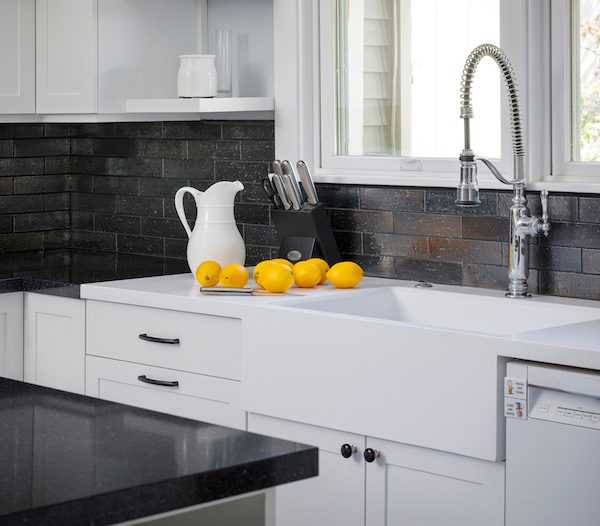
3. Healthier countertops.
Quartz and quartzite replaced granite as go-to surfaces years ago, primarily because they are less ubiquitous, more durable and nonporous, and associated with greater healthfulness due to their antimicrobial properties, says designer Chris Dreith of The Home Improvements Group. The main differences between them are that quartz is manmade and easier for fabricators to match patterns, while quartzite is a natural stone and it takes effort to find slabs with grains that work together. Quartzite can handle higher heat without burning—up to 500 degrees versus 275 for quartz, says De Giulio. There are also materials like Staron®, an acrylic option that’s engineered to be nonporous and is more affordable than quartz, quartzite, marble, and granite.

4. Bolder backsplashes.
Backsplashes have become a way to add personality to a kitchen. Fennessy says more people are moving beyond traditional rectangular subway tiles to herringbone, hexagonal, picket fence, and penny-round mosaic patterns. De Giulio adds visual warmth and character backsplashes with a mix of materials such as textured wood and shiny metal. Another way to introduce boldness is with a single slab covering the backsplash, which eliminates cleaning grout lines, says Korangy. When homeowners tire of their choice, a backsplash is among the easiest, most affordable changes, according to Swarz.
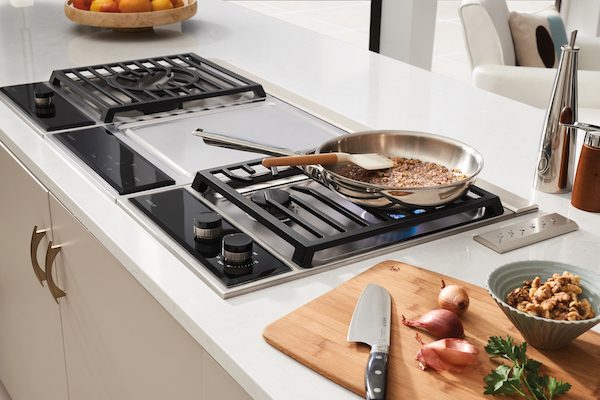
5. Multitasking appliances.
With so many demands placed on the kitchen, homeowners are favoring appliances that serve multiple functions. Dreith says many clients are choosing steam/convection ovens and hot water/filtration systems. Cooking more at home has led to bigger appliances, from longer sinks—sometimes five feet and with features like sliding cutting boards—to tall columns designated for refrigeration or freezing, and more personalized components. SubZero, Wolf, and Cove now offer 15-inch modules that let the homeowner assemble their ideal cooktop, with options such as a wok, deep fryer, and gas or eclectic oven options, says Jeff Sweet, corporate manager of product marketing. Many homeowners are also looking for help from technology. SubZero’s new Cove dishwasher line has a partnership with Amazon and can alert homeowners when they need more detergent pods. And faucets now come in water-efficient, no-touch options.
6. Better ventilation and purer water.

To stay healthy, safe drinking water and fresh air no longer mean having just a purification system attached to a faucet or venting odors and stale air through a range hood. Homeowners want a water purification system for their entire house, says real estate salesperson Tony Mariotti, CEO of RubyHome. He has clients who like to shower with “conditioned” water. To achieve proper ventilation, some homeowners are adding larger windows as well as installing a hood blower with a larger capacity. The size depends on room dimensions, odors produced, and the equipment’s cubic feet per minute (cfms). De Giulio likes to dial back vent noise by placing equipment in an adjacent space and suggests homeowners consult an HVAC specialist. “It’s a tricky science,” he says. But something as simple as houseplants can help purify air, says Gena Kirk, vice president of KB Design Studio for KB Home.
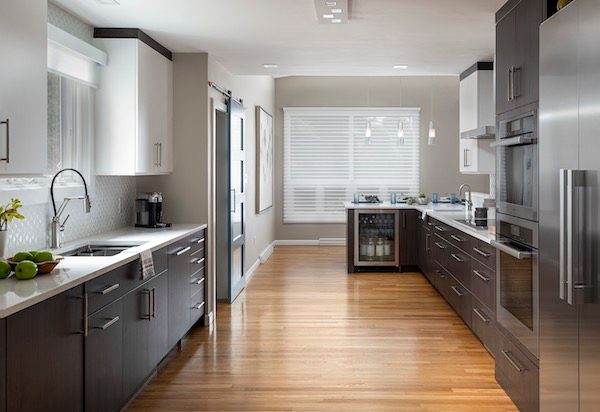
7. Warmer, efficient lighting.
LEDs have grabbed the spotlight, whether under, in, and above cabinets, in ceilings, and along toe kicks. One reason, they’re more energy efficient; another—technology has made it easier to achieve a warmer, dimmable LED, which Gilder favors. She suggests a range between 3,000 and 4,000 kelvins (K). In addition, LEDs are programmable to vary in brightness and colors, says Dreith. Houzz found pendant lighting remains popular dangling above an island, but some experts, like Brooks, now prefer one substantial fixture.
8. More specialized storage.
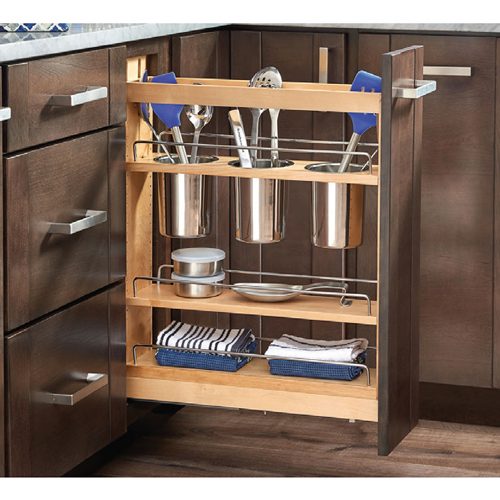
Besides needing better storage for buying in bulk and making fewer runs to stores, homeowners are also looking to designers to help find places to better stash pantry goods, dishes, glasses, cutlery, and small appliances, says Mary Cook, president of Mary Cook Associates, a design firm. Some homeowners are adding on “super pantries,” akin to small, second kitchens, says Zuber. If space and budget don’t permit something that large, Fennessy recommends building a pantry cabinet with rollout shelves and room at the bottom for taller items.
When it comes to cabinetry, drawers are preferred to cabinets since they’re easier to access, says Dreith. Flat rather than shaker style is also favored for easier cleaning and they because they can be dressed up with hardware, says Brooks. Homeowners are interested in cabinet systems to organize everything from cookie sheets to spices to recycling bins, Houzz found. Those who prefer a modern look want some open shelves rather than all cabinets on top, says Rodriguez.

9. Sturdier floors.
More people at home equate to more wear and tear on floors, so durable, easy-to-clean choices rank high. The Houzz survey found that vinyl wood-style planks have become more popular than hardwood, but many designers like Fennessy say clients prefer hardwood and engineered wood over vinyl wood planks to mimic the modern farmhouse look. De Giulio’s clients favor wider planks, as well as old-fashioned, elegant, hand-scraped floors.
10. Auxiliary outdoor kitchens.
Homeowners value outdoor space more than ever. Designer Cristin Michele Beavers, a real estate salesperson and founder of CMB Designs, outfits clients’ Southern California yards with all the bells and whistles, from pizza ovens and smokers to wine fridges, warming drawers, heaters, furniture, and fireplaces. The warm weather locations offer incentive to invest in the outdoor living area. De Giulio says many of his clients request a good grill, countertop, and maybe an outdoor sink.

No matter the makeover a homeowner is planning, they should be aware of the lumber shortage in the U.S., which is increasing costs of materials and labor. Eventually, “when production and distribution rise to meet demand,” Zuber expects costs will decrease. “A lot was due to people getting sick and factories shutting.”
Is the White Kitchen Passé?
Despite a 4% decline from the prior year, white remains the most popular color choice for kitchens, according to the 2021 Houzz survey, followed by wood tones, then gray. But the bigger news is that many multicolor (often bold) kitchens are steadily growing in preference, says Brunstrum. Reasons cited are that homeowners want to personalize the room and have less concern about resale or what the next buyer wants.
Colors and different materials and textures now appear in myriad ways. Swartz is designing cabinetry in pine green, robin’s egg blue, and navy. Albanese, says pink tiles are back but in a soft rather than bubblegum ‘50s hue. Designer Katja Van der Loo of Papyrus Home Design is wallpapering kitchens again, which might introduce a mix of colors. Korangy mixes it all up: In one kitchen, blackened steel countertops with marble backsplash and laminate cabinets, and in another, salvaged wood, laminate wall surface, quartz countertop, and stainless steel toe kick.
Even appliances come in colors. Brunstrum paired a red range with blue cabinets. Fennessy predicts orange and magenta will be huge, along with more perimeter and island cabinets and countertops displaying different palettes, a trend from years ago that is re-emerging.
New condo developments, often tamer and more monochromatic, now offer greater color choices with their finish packages. At the Parkline Chicago development, residents can choose from four palettes to meet individual aesthetics, says Thomas Roszak, president of Parkline developer Moceri + Roszak.

No comments:
Post a Comment